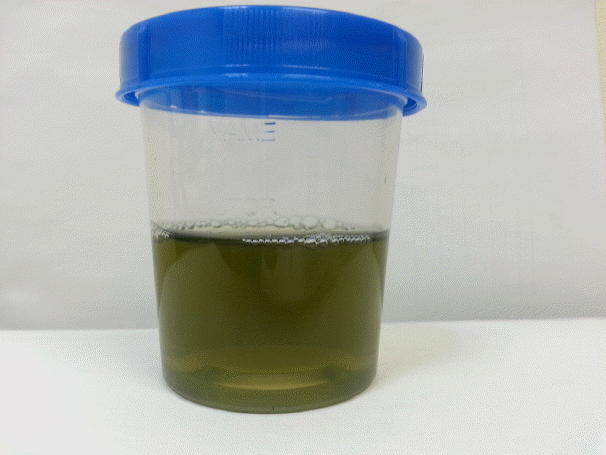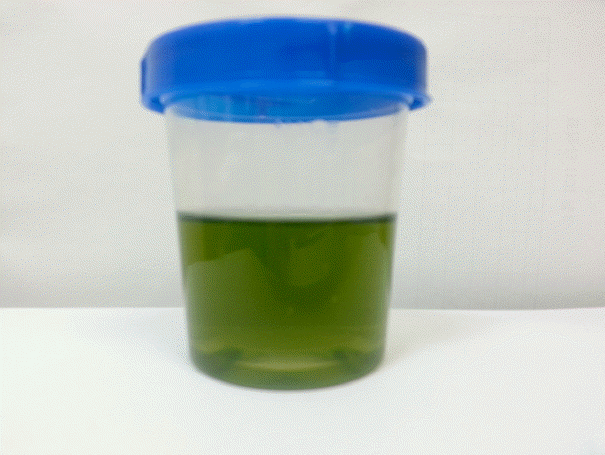Abstract
Urine discoloration occurs in the intensive care unit (ICU) due to many causes such as medications, metabolic disorders, and infections. Propofol is advocated as one of the first line sedatives in the ICU, but it is not well known to the intensivists that propofol can induce urine color change. We experienced two cases of green urine after propofol infusion. Propofol should be warranted as the cause of urine discoloration during ICU stay.
Urine discoloration at the intensive care unit (ICU) is common. And, it is important to investigate the causes and correct them because urine discoloration may indicate serious underlying disorders. Green-colored urine is caused by medications, ingestion of substances, infection, metabolic disorders, and structural abnormalities.[1] Propofol is widely used in the operating rooms as an induction and maintenance agent and in the ICU as a sedative agent because of its characteristics such as rapid onset of action and short duration. We experienced two cases of green urine after propofol infusion in the ICU and reviewed the cause of it.
A 55-year-old man was admitted to the surgical ICU after a pelvic mass wide excision, partial cystectomy, suprapubic cystostomy, and adhesiolysis of mass to rectum because of recurred chondrosarcoma in the pelvis. During a long time of operation of 13 hours and 30 minutes, the patient suffered massive bleeding (more than 14,000 ml) and hypovolemic status; he received inotropic agents as well as transfusion through the perioperative period. Therefore, we decided to sedate him with propofol and remifentanil for ventilator care at the ICU. 72 hours after he was admitted into the ICU, the patient’s urine color had turned to green (Fig. 1). Urinalysis showed a pH of 5.5, specific gravity of 1.016, negative bilirubin content, and 1.0 µmol/L of urobilinogen. Blood examination revealed serum albumin level of 2.4 g/dL, aspartate transaminase (AST) 92 IU/L, alanine transaminase (ALT) 26 IU/L, blood urea nitrogen (BUN) 7.9 mg/dL, 0.41 mg/dL of creatinine, and 0.9 mg/dL of total bilirubin. Urine culture was negative. Because he had a complicated abdominal pelvic surgery, we were concerned that there may be an intestinal-urinary fistula, so we let him take an abdominal pelvic computed tomography (CT), but any fistula between the intestine and urinary system was not seen.
On postoperative day (POD) 5, the patient had a surgery of hematoma evacuation in the pelvis and debridement. When he returned to the ICU, the sedative regimens were changed to midazolam and fentanyl. After coming back to the ICU, the urine color was yellowish brown, and the laboratory test was repeated. The result was the following; a pH of 5.5, specific gravity of 1.019, a negative bilirubin content, 0.2 µmol/L of urobilinogen in the urinalysis, and serum albumin level of 2.3 g/dL, AST 97 IU/L, ALT 24 IU/dL, BUN 7.3 mg/dL, 0.40 mg/dL of creatinine, and 1.7 mg/dL of total bilirubin in the blood examination. During ICU admission, propofol was not given to him again, and the urine color was not changed.
A 28-year-old woman was admitted into the ICU in an intubated status. She was transferred after having gotten mandible ostectomy and genioplasty from the local plastic surgery clinic with massive bleeding intraoperative period. Even though her mental status was alert, considering the hypovolemic status and unsecured airway due to facial and neck swelling, we decided to postpone extubation and sedated her with propofol and remifentanil. After 48 hours of propofol infusion, the urine color changed to green (Fig. 2). Urinalysis showed a pH of 6.0, specific gravity of 1.014, negative bilirubin content, and 2.0 µmol/L of urobilinogen. Blood examination revealed serum albumin level of 2.7 g/dL, AST 22 IU/L, ALT 11 IU/L, BUN 6.7 mg/dL, creatinine 0.43 mg/dL, and total bilirubin 0.3 mg/dL. Urine culture was negative. On POD 3, her facial and neck swelling subsided, and she passed the leak test. Therefore, we stopped propofol infusion and extubated endotracheal tube. After 3 hours of propofol discontinuity, the urine color turned to yellow and repeated laboratory tests including urinalysis, blood examination, and cultures were not remarkable.
When we notice changes of urine color in the ICU, the first step is a subjective determination of color, because each color has differential diagnosis. Then, a detailed history focusing on ingestion of medications and substances should be done. After that, specific laboratory tests such as urinalysis, urine and blood cultures are considered according to the differential diagnosis.[2] A CT scan could be necessary for elucidate anatomical problems[3] as in case 1.
Medications, which can cause green urine by phenol’s conjugation in the liver are promethazine, thymol, cimetidine, and propofol.[3] And, some nonphenol medications such as metoclopramide,[4] amitriptyline,[5] and indomethacin are reported to induce green urine. Food coloring, Listerine mouthwash, Clorets mints, indigo dyes, and methylene blue are also causes of green urine.[6] Besides taking medications or substances, pseudomonas infection, metabolic disorders such as Hartnup disease and blue diaper syndrome, and enterovesical fistular induce green urine.[1,3,7]
After thorough review of these two cases, propofol metabolite seemed to be the main cause of green discoloration of urine. Propofol metabolites such as the 4-sulfate and 1- or 4-glucuronide conjugates of 2, 6-diisopropyl-1, 4-quinol are excreted in the urine after glucoconjugation in the liver.[8,9] Even though many cases reported that green discoloration of urine after long-term propofol infusion,[9–11] a single bolus of propofol also induce green colored urine.[6] Therefore, total dosage or length of infusion does not seem to be related to urine discoloration. Rather, Shioya et al. suggested that green urine discoloration is associated with propofol extrahepatic glucuronidation mainly in the kidneys because of enterohepatic circulation impairment due to constipation and diminished peristalsis.[11] A few cases showed elevated urine urobilinogen, which is also seen in our cases, as a marker of liver dysfunction and elevated extrahepatic pathway metabolism of propofol.[9,11] However, some reports indicated negative or little elevation of urobilinogen.[7,12]
Interestingly, propofol may cause transient pink[13] and white[14] urine discoloration due to uric acid crystals and the propofol emulsion. Green-colored urine is not common and may alarm patients and their families as well as caregivers. However, it does not reflect altered renal function and is a benign phenomenon,[15] and the discoloration disappears after propofol discontinuation within a couple days. Therefore, when green urine is noticed at the ICU, it is important that the cause is investigated thoroughly in order to avoid unnecessary concerns or laboratory tests.
References
2). Raymond JR, Yarger WE. Abnormal urine color: differential diagnosis. South Med J. 1988; 81:837–41.

6). Barbara DW, Whalen FX Jr. Propofol induction resulting in green urine discoloration. Anesthesiology. 2012; 116:924.

9). Lee JS, Jang HS, Park BJ. Green discoloration of urine after propofol infusion. Korean J Anesthesiol. 2013; 65:177–9.

10). Ku BD, Park KC, Yoon SS. Dark green discoloration of the urine after prolonged propofol infusion: a case report. J Clin Pharm Ther. 2011; 36:734–6.

11). Shioya N, Ishibe Y, Shibata S, Makabe H, Kan S, Matsumoto N, et al. Green urine discoloration due to propofol infusion: a case report. Case Rep Emerg Med. 2011; 2011:242514.

13). Masuda A, Hirota K, Satone T, Ito Y. Pink urine during propofol anesthesia. Anesth Analg. 1996; 83:666–7.





 PDF
PDF ePub
ePub Citation
Citation Print
Print




 XML Download
XML Download